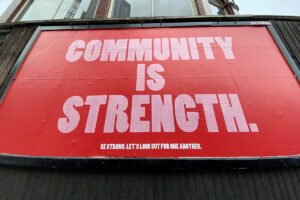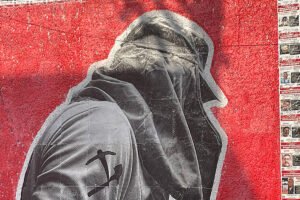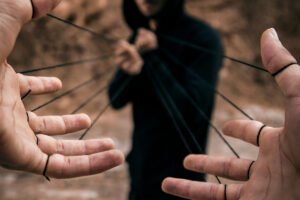
When we last wrote about White men’s participation in racial justice work for NPQ in October 2023, we described how nine White men participating in the 60th anniversary of the March on Washington, wearing shirts that read “White Men for Racial Justice,” was novel enough to spark curiosity and enthusiasm from fellow marchers.
This summer, progressive White male organizing has attracted far more than nine people. We were encouraged by Showing Up For Racial Justice’s (SURJ) “White Men Against MAGA” call, which attracted 1,200 participants via Zoom. That was followed by “White Dudes for Harris,” a massive online event, which an estimated 200,000 people attended.
There is power in White male leaders acknowledging their own identities and then speaking in support of justice.
While these numbers are eye-catching, are they meaningful? Certainly, there remains a large White supremacist movement in the United States that is every bit as dangerous as critics claim. But what is new is that progressive White men are starting to organize their own movement for justice at a mass scale. We see this response by White men to reject White supremacy as a major and extremely hopeful development.
What this suggests to us is that White men are beginning to organize, to willingly engage with the complexities of identity politics, and, in essence, say, “Not in our name.”
Laying the Groundwork
The mass meetings mentioned above were directly inspired by prior calls organized by Black women, Black men, and White women for their own demographic groups, which had also attracted large numbers. They were also made possible by the groundwork laid by the Black- and Indigenous-led racial justice movement over time, particularly over the last decade.
The SURJ call, held on July 25, was catalyzed by longtime organizers Chris Crass, Greg Horwitch, and Z! Haukeness. SURJ has been organizing White men since 2009 (the group was originally formed to support then-newly elected president Barack Obama) and facilitated an hour-long call that reached an audience of primarily activists.
“Our objective,” SURJ director Erin Heaney told us, “was to bring White men into voter contact work, as an entry point into providing a long-term political home within movements for justice.”
A Massive Online Call
A sense of fun and joy is needed to attract people to movements.
The White Dudes for Harris call, held on July 29 and organized by Ross Morales Rocketto and a dozen others, featured a nearly three-and-a-half-hour program. Structured in some ways like a telethon, the event raised an estimated $4.5 million for the Harris campaign. Prominent speakers included Erin Heaney, Maurice Mitchell (director of the Working Families Party), and a star-studded lineup of “White dudes”—dubbed by West Wing actor Bradley Whitford as a “rainbow of beige”—that included vice presidential hopefuls Secretary Pete Buttigieg and Governor (and recent vice presidential pick) Tim Walz, as well as celebrities such as Jeff Bridges, Mark Hamill, and Joseph Gordon-Levitt.
These calls suggest a potential sea change in White men’s engagement in movements for justice. One speaker on the call stated it was the largest gathering of White men ever, surpassing a Ku Klux Klan rally in Washington, DC, a century ago.
Moments like these could matter come election day in November. As multiple speakers pointed out, if White male support for Harris increases by even a couple of percentage points, that could shift the election outcome decisively in her favor. But these moments may be even more important culturally.
There is power in White male leaders acknowledging their own identities and then speaking in support of justice. Event organizers told us that they received dozens of photos of dads watching with their children. In a society where most White men have historically been reluctant to describe themselves as such, even the refrain of the simple phrase “as a White man” was groundbreaking.
Sign up for our free newsletters
Subscribe to NPQ's newsletters to have our top stories delivered directly to your inbox.
By signing up, you agree to our privacy policy and terms of use, and to receive messages from NPQ and our partners.
Changing the Conversation
We can understand why it has taken until now for White men to get organized for racial justice at scale. One reason, of course, is that politically speaking, White men have been part of Donald Trump’s political base. Exit poll data indicate that between 58 and 61 percent of White males in the 2020 presidential election voted for Trump. Of course, this meant that between 38 and 40 percent of White males in the 2020 election voted for Joe Biden, but many of these men have felt politically isolated—and, for that reason, have been reluctant to openly engage in political organizing, particularly political organizing rooted in their identity as White men.
What excites us most about these calls is they transcended some of the characteristics that have led many White men to resist so-called “identity politics” in recent years. For example, there was a commitment to nuance that was less prominent among White advocates for justice five years ago. Many speakers avoided binaries and lifted up notions that honor complexity, such as the idea that identity is critical to consider yet far from the only thing that matters. Moreover, the call included a range of speakers with varying backgrounds and viewpoints: there were activists and politicians but also union leaders, police officers, military veterans, and more. Bolstered by an air of humility, the calls demonstrated to participants that they didn’t have to agree on everything or use the same messaging in order to work toward a common purpose.
The way White men were talked about was also different from what we have seen in some other settings. Several speakers offered examples of how White men have made positive contributions to movements for justice. When speakers were tough on their fellow White men, they often approached the task with humor, levity, and a willingness to poke fun at themselves, which is meaningful because a sense of fun and joy is needed to attract people to movements.
While “movement moments”…are lifegiving, they are ultimately only one step on the path to enacting cultural change.
How to Build on the Momentum
Activist Chris Crass emphasizes how crucial it is to bring positive energy when organizing White men. Crass told us that, “after Trump’s election, anger toward White men understandably rose, and trust plummeted. Some of us who had been building the White antiracist movement began focusing specifically on White men. And we’ve approached this endeavor with a positive, liberatory vision and organizing framework for White men to connect their shared interest with multiracial, multigender movements for racial, gender and economic justice.”
Not everyone is convinced by the potential of mass meetings. Notably, of roughly 100 million White men in the United States, only a tiny fraction attended either of the calls mentioned here. Even among those who did attend, some were quick to point out to us that joining an online event isn’t the same as a deep commitment to transformation. Among participants on the calls who spoke with us, some criticized the messaging of certain speakers, which they felt villainized the opposition, deployed aggressive language, and overemphasized what they were against and underemphasized what they were for.
Still, we see reasons to be hopeful. Morales Rocketto said that “the turnout demonstrates that there is a hunger among White men to be in community in helpful ways.”
White men aren’t alone in feeling hopeful. Scholar Kimberlé Crenshaw, who coined the term “intersectionality,” described these identity-based mobilization efforts as a “remarkable moment.”
“It suggests to me,” Crenshaw told Vox, “that there is a greater awareness than ever before that in order to secure some protection against the further disintegration of our democracy, people have to be willing to organize in their own communities.”
For the emerging movement of White men who are committed to justice, there is a long road ahead. While “movement moments” like these are lifegiving, they are ultimately only one step on the path to enacting cultural change. To generate lasting results, sustained engagement is needed. The next task, which organizers of both calls emphasized, is to ensure that those who joined the calls are invited into opportunities for long-term, relational organizing—that is, harnessing energy from these calls in ways that produce durable support for lasting cultural change.
Efforts we’ve written about previously—such as Breaking the Mold, White Dudes for Collective Liberation, Organizing White Men for Collective Liberation, Punch Up, Showing Up for Racial Justice, Solidaire Network, and White Men for Racial Justice—are eager to offer community and assistance to White men who want to positively contribute to today’s movements for justice.
A door toward cultural change has been opened, but millions of White men still must choose to walk through it.
Garrett Neiman and Otis Pitney are co-conveners of the Perennial Sunflower Project, a field building nonprofit that is supporting and strengthening the emerging movement of White men who are partnering across differences to advance equity and justice.











